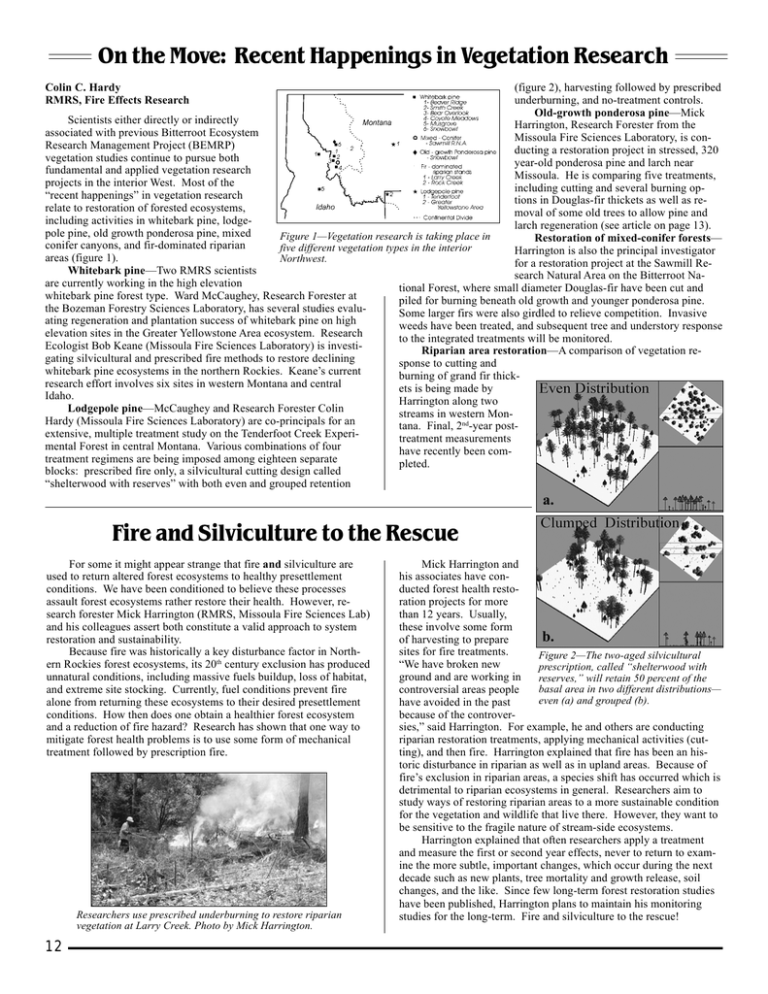On the Move: Recent Happenings in Vegetation Research
advertisement

On the Move: Recent Happenings in Vegetation Research Colin C. Hardy RMRS, Fire Effects Research (figure 2), harvesting followed by prescribed underburning, and no-treatment controls. Old-growth ponderosa pine—Mick Scientists either directly or indirectly Harrington, Research Forester from the associated with previous Bitterroot Ecosystem Missoula Fire Sciences Laboratory, is conResearch Management Project (BEMRP) ducting a restoration project in stressed, 320 vegetation studies continue to pursue both year-old ponderosa pine and larch near fundamental and applied vegetation research Missoula. He is comparing five treatments, projects in the interior West. Most of the including cutting and several burning op“recent happenings” in vegetation research tions in Douglas-fir thickets as well as rerelate to restoration of forested ecosystems, moval of some old trees to allow pine and including activities in whitebark pine, lodgelarch regeneration (see article on page 13). pole pine, old growth ponderosa pine, mixed Figure 1—Vegetation research is taking place in Restoration of mixed-conifer forests— conifer canyons, and fir-dominated riparian five different vegetation types in the interior Harrington is also the principal investigator areas (figure 1). Northwest. for a restoration project at the Sawmill ReWhitebark pine—Two RMRS scientists search Natural Area on the Bitterroot Naare currently working in the high elevation tional Forest, where small diameter Douglas-fir have been cut and whitebark pine forest type. Ward McCaughey, Research Forester at piled for burning beneath old growth and younger ponderosa pine. the Bozeman Forestry Sciences Laboratory, has several studies evaluSome larger firs were also girdled to relieve competition. Invasive ating regeneration and plantation success of whitebark pine on high weeds have been treated, and subsequent tree and understory response elevation sites in the Greater Yellowstone Area ecosystem. Research to the integrated treatments will be monitored. Ecologist Bob Keane (Missoula Fire Sciences Laboratory) is investiRiparian area restoration—A comparison of vegetation regating silvicultural and prescribed fire methods to restore declining sponse to cutting and whitebark pine ecosystems in the northern Rockies. Keane’s current burning of grand fir thickresearch effort involves six sites in western Montana and central ets is being made by Idaho. Harrington along two Lodgepole pine—McCaughey and Research Forester Colin streams in western MonHardy (Missoula Fire Sciences Laboratory) are co-principals for an tana. Final, 2nd-year postextensive, multiple treatment study on the Tenderfoot Creek Experitreatment measurements mental Forest in central Montana. Various combinations of four have recently been comtreatment regimens are being imposed among eighteen separate pleted. blocks: prescribed fire only, a silvicultural cutting design called “shelterwood with reserves” with both even and grouped retention a. Fire and Silviculture to the Rescue For some it might appear strange that fire and silviculture are used to return altered forest ecosystems to healthy presettlement conditions. We have been conditioned to believe these processes assault forest ecosystems rather restore their health. However, research forester Mick Harrington (RMRS, Missoula Fire Sciences Lab) and his colleagues assert both constitute a valid approach to system restoration and sustainability. Because fire was historically a key disturbance factor in Northern Rockies forest ecosystems, its 20th century exclusion has produced unnatural conditions, including massive fuels buildup, loss of habitat, and extreme site stocking. Currently, fuel conditions prevent fire alone from returning these ecosystems to their desired presettlement conditions. How then does one obtain a healthier forest ecosystem and a reduction of fire hazard? Research has shown that one way to mitigate forest health problems is to use some form of mechanical treatment followed by prescription fire. Researchers use prescribed underburning to restore riparian vegetation at Larry Creek. Photo by Mick Harrington. 12 Mick Harrington and his associates have conducted forest health restoration projects for more than 12 years. Usually, these involve some form b. of harvesting to prepare sites for fire treatments. Figure 2—The two-aged silvicultural “We have broken new prescription, called “shelterwood with ground and are working in reserves,” will retain 50 percent of the basal area in two different distributions— controversial areas people even (a) and grouped (b). have avoided in the past because of the controversies,” said Harrington. For example, he and others are conducting riparian restoration treatments, applying mechanical activities (cutting), and then fire. Harrington explained that fire has been an historic disturbance in riparian as well as in upland areas. Because of fire’s exclusion in riparian areas, a species shift has occurred which is detrimental to riparian ecosystems in general. Researchers aim to study ways of restoring riparian areas to a more sustainable condition for the vegetation and wildlife that live there. However, they want to be sensitive to the fragile nature of stream-side ecosystems. Harrington explained that often researchers apply a treatment and measure the first or second year effects, never to return to examine the more subtle, important changes, which occur during the next decade such as new plants, tree mortality and growth release, soil changes, and the like. Since few long-term forest restoration studies have been published, Harrington plans to maintain his monitoring studies for the long-term. Fire and silviculture to the rescue!



